window OLDSMOBILE SILHOUETTE 1998 Owners Manual
[x] Cancel search | Manufacturer: OLDSMOBILE, Model Year: 1998, Model line: SILHOUETTE, Model: OLDSMOBILE SILHOUETTE 1998Pages: 444, PDF Size: 23.2 MB
Page 11 of 444
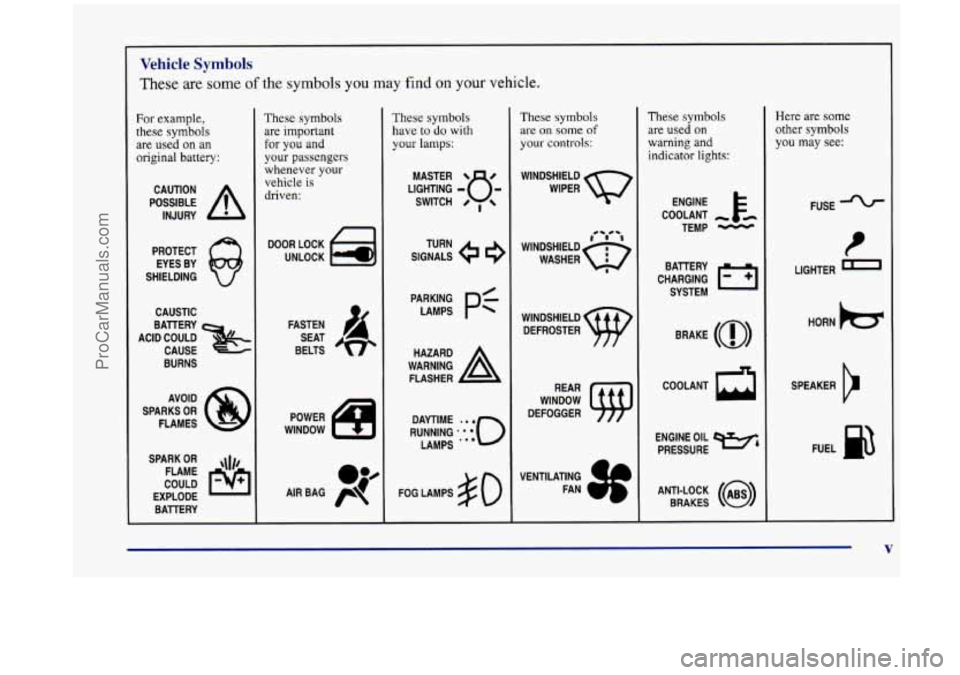
Vehicle Symbols
These are some of the symbols you may find on your vehicle.
For example,
these symbols are used on an
original battery:
POSSIBLE A
CAUTION
INJURY
PROTECT EYES BY
SHIELDING
CAUSTIC
ACID COULD BAllERY
CAUSE
BURNS
AVOID
SPARKS
OR
FLAMES
SPARK
OR ,\I/,
COULD FLAME
EXPLODE BAllERY
These symbols
are important
for you and
your passengers
whenever
your
vehicle is
driven:
DOOR LOCK
UNLOCK
FASTEN SEAT
BELTS
These symbols
have to do with
your lamps:
SIGNALS e
TURN
WARNING
A
HAZARD
FLASHER
FOG LAMPS
$0
These symbols
are on some of
your controls:
WINDSHIELD
WIPER
WINDSHIELD DEFROSTER
WINDOW
DEFOGGER
These symbols
are used on
warning and indicator lights:
ENGINE E*
COOLANT
TEMP
-
CHARGING I-1
BATTERY
SYSTEM
BRAKE
(a)
COOLANT a
ENGINE OIL e,
PRESSURE
ANTI-LOCK
(@)
BRAKES
Here are some other symbols you may see:
FUSE
LIGHTER
m
HORN )cr
SPEAKER
b
FUEL e3
ProCarManuals.com
Page 56 of 444
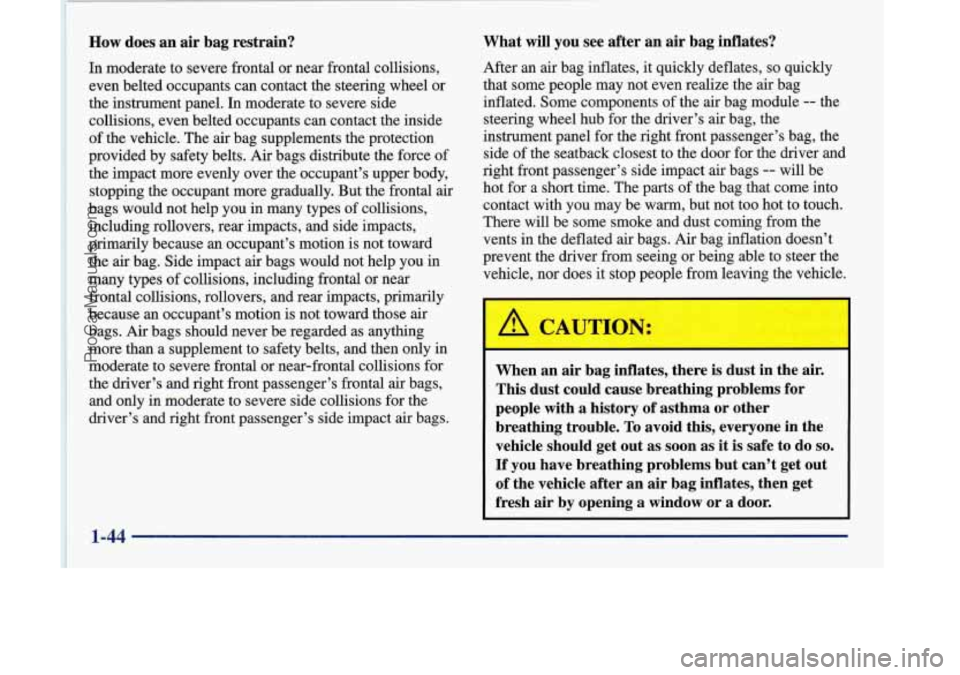
How does an air bag restrain?
In moderate to severe frontal or near frontal collisions,
even belted occupants can contact the steering wheel or
the instrument panel. In moderate
to severe side
collisions, even belted occupants can contact the inside
of the vehicle. The
air bag supplements the protection
provided by safety belts. Air bags distribute the force of
the impact more evenly over the occupant’s upper body,
stopping the occupant more gradually. But the frontal
air
bags would not help you in many types of collisions,
including rollovers, rear impacts, and side impacts,
primarily because an occupant’s motion is not toward
the air bag. Side impact air bags would not help you in
many types of collisions, including frontal or near
’ frontal collisions, rollovers, and rear impacts, primarily
because an occupant’s motion is not toward those air
bags.
Air bags should never be regarded as anything
more than a supplement to safety belts, and then only in
moderate to severe frontal or near-frontal collisions for
the driver’s and right front passenger’s frontal air bags,
and only in moderate to severe side collisions for the
driver’s and right front passenger’s side impact air bags.
What will you see after an air bag inflates?
After an air bag inflates, it quickly deflates, so quickly
that some people may not even realize the air bag
inflated. Some components of the air bag module
-- the
steering wheel hub for the driver’s
air bag, the
instrument panel for the right front passenger’s bag, the
side of the seatback closest to the door for the driver and
right front passenger’s side impact air bags
-- will be
hot for a short time. The parts of the bag that come into
contact with you may be warm, but not too hot to touch.
There will be some smoke and dust coming from the
vents in the deflated air bags. Air bag inflation doesn’t
prevent the driver from seeing or being able to steer the
vehicle, nor does it stop people from leaving the vehicle.
When an air bag inflates, there is dust in the air.
This dust could cause breathing problems for
people with
a history of asthma or other
breathing trouble. To avoid this, everyone in the
vehicle should get out
as soon as it is safe to do so.
If you have breathing problems but can’t get out
of the vehicle after an air bag inflates, then get
fresh air by opening a window or a door.
1-44
ProCarManuals.com
Page 59 of 444
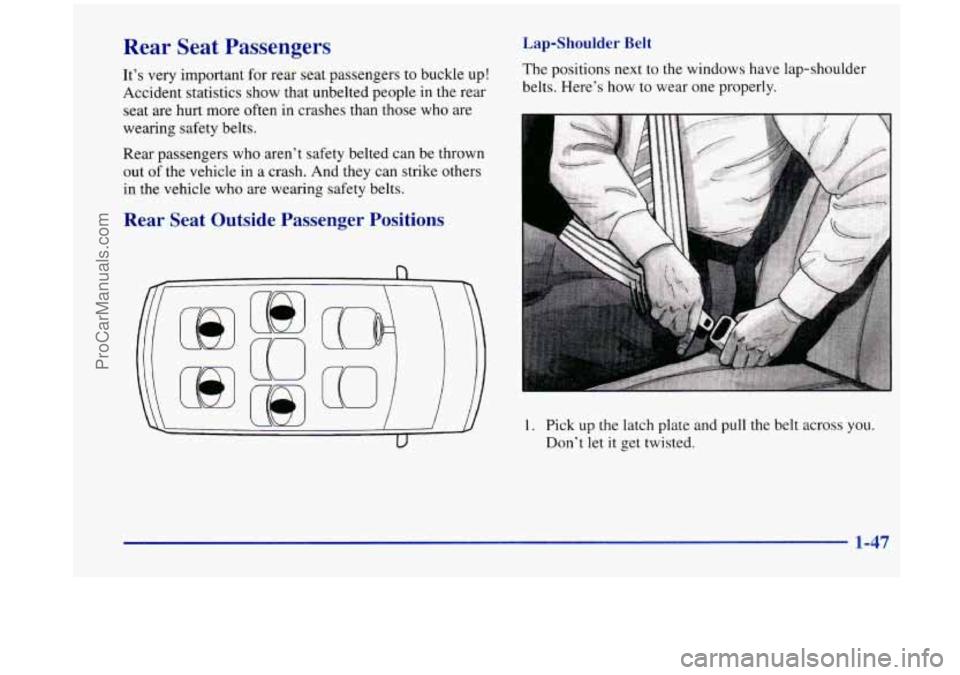
Rear Seat Passengers
It’s very important for rear seat passengers to buckle up!
Accident statistics show that unbelted people in the rear
seat are hurt more often in crashes than those who are
wearing safety belts.
Rear passengers who aren’t safety belted can be thrown
out
of the vehicle in a crash. And they can strike others
in the vehicle who are wearing safety belts.
Lap-Shoulder Belt
The positions next to the windows have lap-shoulder
belts. Here’s how
to wear one properly.
Rear Seat Outside Passenger Positions
1. Pick up the latch plate and pull the belt across you.
Don’t let it get twisted.
1-47
ProCarManuals.com
Page 86 of 444
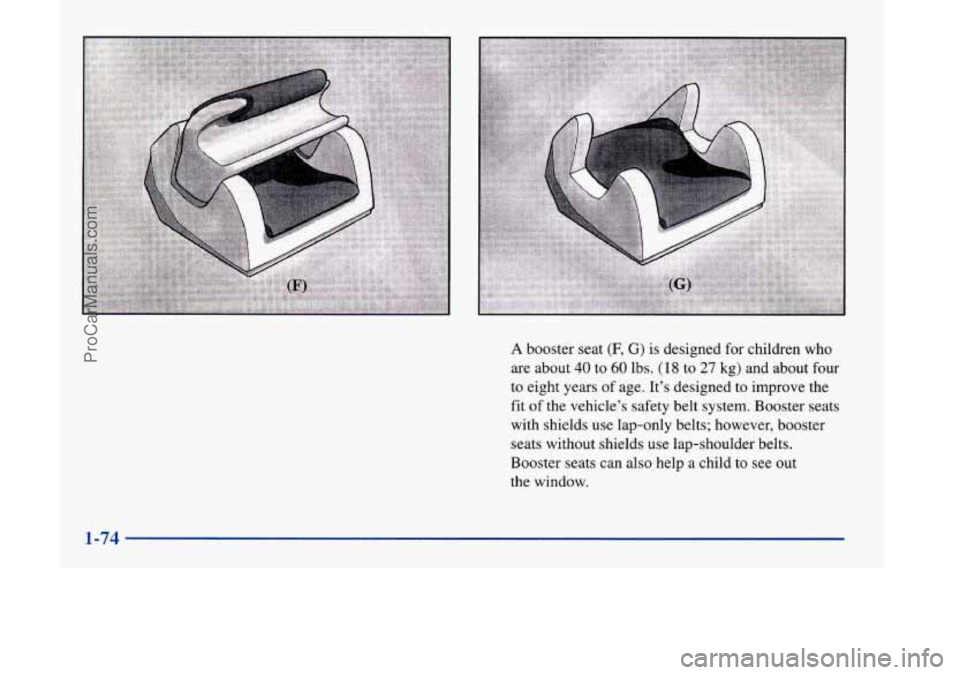
A booster seat (F, G) is designed for children who
are about
40 to 60 lbs. (18 to 27 kg) and about four
to eight years of age. It’s designed to improve the
fit of the vehicle’s safety belt system. Booster seats
with shields use lap-only belts; however, booster
seats without shields use lap-shoulder belts.
Booster seats can also help a child to see out
the window.
1-74
ProCarManuals.com
Page 98 of 444
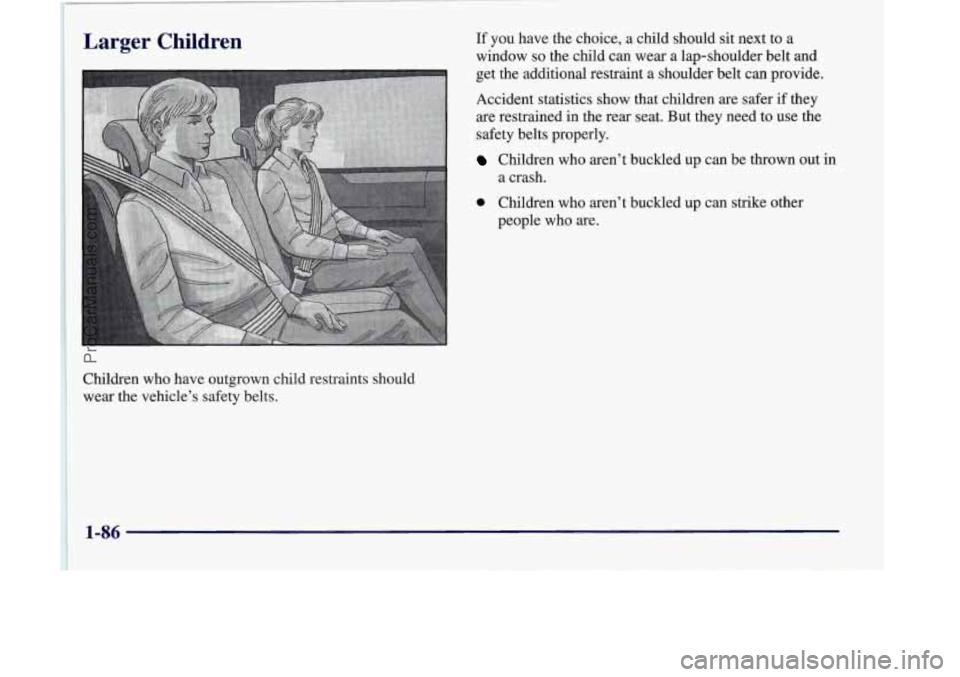
Larger Children
1
Children who have outgrown child restraints should
wear the vehicle’s safety belts. If
you have the choice, a child should sit next to a
window
so the child can wear a lap-shoulder belt and
get the additional restraint a shoulder belt can provide.
Accident statistics show that children are safer
if they
are restrained in the rear seat. But they need to use the
safety belts properly.
Children who aren’t buckled up can be thrown out in
0 Children who aren’t buckled up can strike other
a
crash.
people who are.
1-86
!
ProCarManuals.com
Page 103 of 444
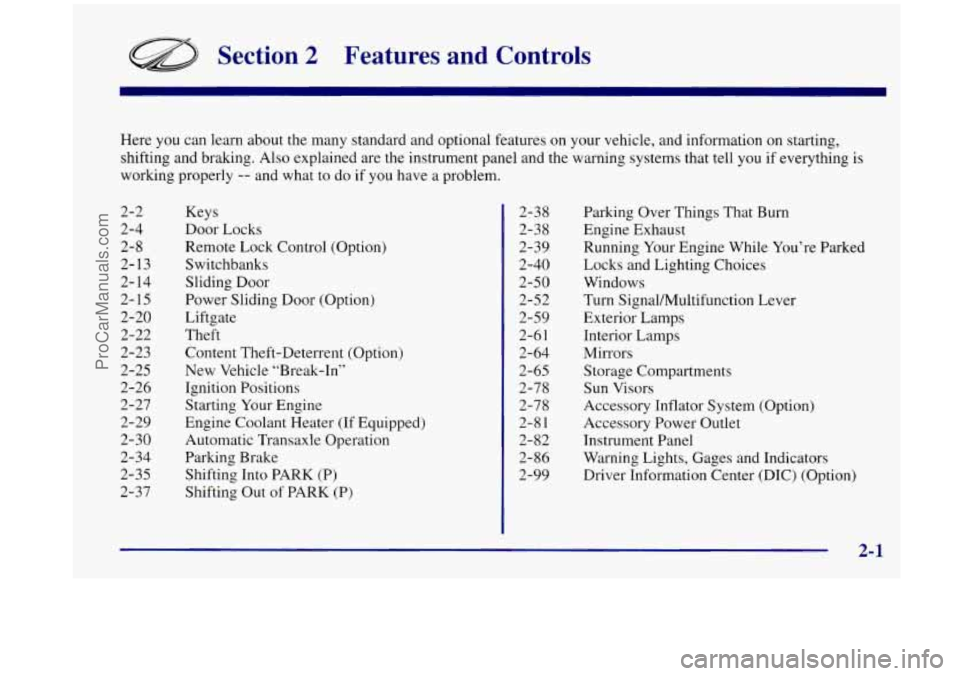
Section 2 Features and Controls
Here you can learn about the many standard and optional features on your vehicle, and information on starting,
shifting and braking. Also explained are the instrument panel and the warning systems that tell you if everything is
working properly
-- and what to do if you have a problem.
2-2
2-4
2-8
2-13
2-
14
2-15
2-20
2-22
2-23
2-25
2-26
2-27
2-29
2-30
2-34 2-35
2-37 Keys
Door Locks
Remote Lock Control (Option)
Switchbanks
Sliding Door
Power Sliding Door (Option)
Liftgate
Theft
Content Theft-Deterrent (Option)
New Vehicle “Break-In”
Ignition Positions
Starting Your Engine
Engine Coolant Heater
(If Equipped)
Automatic Transaxle Operation
Parking Brake
Shifting Into PARK
(P)
Shifting Out of PARK (P)
2-38
2-38
2-39
2-40
2-50
2-52
2-59
2-6
1
2-64
2-65
2-78
2-78
2-8
1
2-82
2-86 2-99 Parking Over Things
That Burn
Engine Exhaust
Running Your Engine While You’re Parked
Locks and Lighting Choices
Windows
Turn SignalMultifunction Lever
Exterior Lamps
Interior Lamps
Mirrors Storage Compartments
Sun Visors
Accessory Inflator System (Option)
Accessory Power Outlet
Instrument Panel
Warning Lights, Gages and Indicators
Driver Information Center (DIC) (Option)
2-1
ProCarManuals.com
Page 104 of 444

Keys
I
Leaving young children in a vehicle with the
ignition key is dangerous for many reasons.
A child or others could be badly injured or
even killed.
They could operate power windows or other
controls or even make the vehicle move. Don't
leave the keys in a vehicle with young children.
2-2
ProCarManuals.com
Page 115 of 444

Switchbanks
There are two sets of switchbanks located in the front of the
vehicle. The switches will vary with the options that are
on
your vehicle. It is useful to become familiar with them since
they are used frequently while operating the vehicle.
Overhead Console Switchbank
This switchbank is located in the overhead console. The
switches that you may find in this switchbank are the
Interior Lights Override, Power Sliding Door Override,
Power Sliding Door and the Power Rear Quarter
Windows. If your vehicle does not have some of the
options controlled by these switches, there will be a
blank button in
its place.
For more information, please see each of these features
in the Index.
Instrument Panel Switchbank
This switchbank is located in the instrument panel below
the comfort controls. The switches and controls that
you
may find in this switchbank are the Rear Fan Knob,
Rear Window Wipermasher, Fog Lamps and Traction
Control. If your vehicle does not have some of the
options controlled by these switches, there will be a
blank button in its place.
For more information, please see each of these features
in the Index.
If your vehicle is not equipped with the optional rear
climate control system, there will be a storage space in
this switchbank. The rubber mat can be removed for
cleaning. Snap the mat into place after cleaning.
2-13
ProCarManuals.com
Page 123 of 444
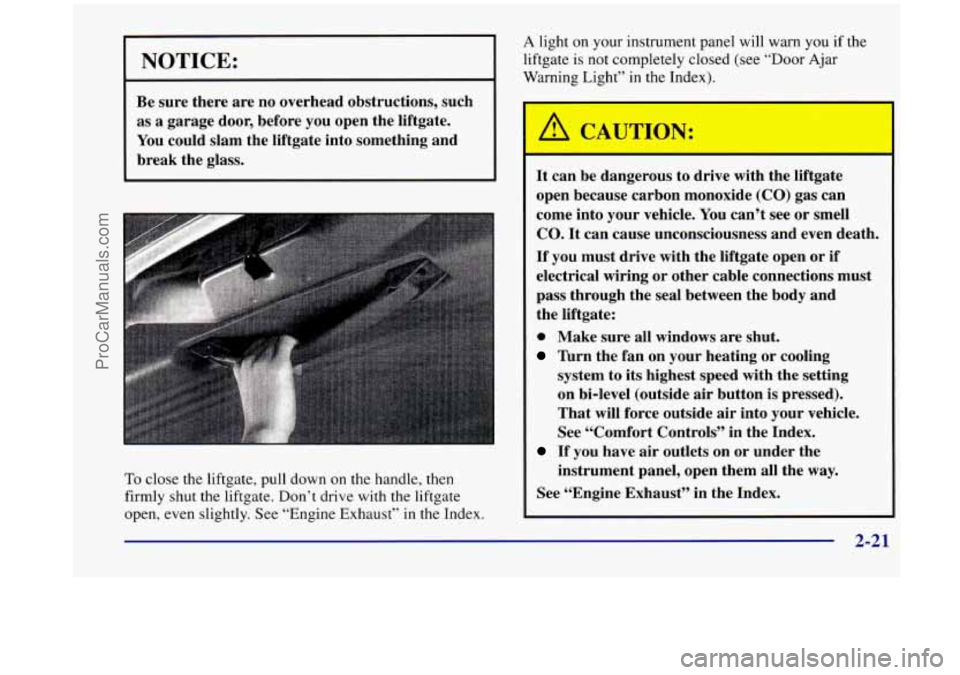
NOTICE:
Be sure there are no overhead obstructions, such
as a garage door, before you open the liftgate.
You could slam the liftgate into something and
break the glass.
To close the liftgate, pull down on the handle, then
firmly shut the liftgate. Don’t drive with the liftgate
open, even slightly. See “Engine Exhaust”
in the Index.
A light on your instrument panel will warn you if the
liftgate
is not completely closed (see “Door Ajar
Warning Light” in the Index).
It can be dangerous to drive with the liftgate open because carbon monoxide
(CO) gas can
come into your vehicle. You can’t see or smell
CO. It can cause unconsciousness and even death.
If you must drive with the liftgate open or if
electrical wiring or other cable connections must
pass through the seal between the body and
the liftgate:
0 Make sure all windows are shut.
Turn the fan on your heating or cooling
system to its highest speed
with the setting
on bi-level (outside air button is pressed).
That will force outside air into your vehicle.
See “Comfort Controls” in the Index.
If you have air outlets on or under the
instrument panel, open them all the
way.
See ‘(Engine Exhaust” in the Index.
2-21
ProCarManuals.com
Page 124 of 444

Theft Parking at Night
Vehicle theft is big business, especially in some cities.
Although your vehicle has a number of theft-deterrent
features, we know that nothing we put on it can make it
impossible to steal. However, there are ways you
can help.
Key in the Ignition
If you leave your vehicle with the keys inside, it’s an
easy target for joy riders or professional thieves
-- so
don’t do it.
When you park your Oldsmobile and open the driver’s
door, you’ll hear a chime reminding you to remove your
key from the ignition and take it with you. Always do
this. Your steering wheel will be locked, and so will
your ignition and transaxle. And remember
to lock
the doors. Park
in a lighted spot,
close all windows and lock your
vehicle. Remember to keep your valuables out of sight.
Put them in a storage area, or take them with you.
Parking Lots
If you park in a lot where someone will be watching
your vehicle, it’s best to lock it
up and take your key.
But what
if you have to leave your key? What if you
have to leave something valuable in your vehicle?
Put your valuables in a storage area, like your
glove box.
Lock all the doors except the driver’s.
2-22
ProCarManuals.com